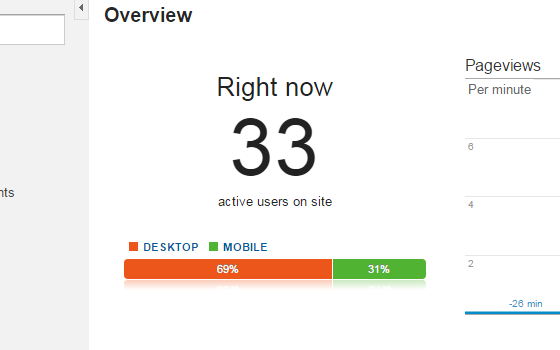Websites
Real-Time Website Analytics: What You Can Learn in the 10 Minutes After Hitting “Send”


BLANCHARD
One of the biggest time-sucks as marketers is analytics.
Dashboards, charts, and reports for miles, it’s easy to get overloaded by numbers. Once that happens, the purpose of those figures can quickly be lost and we’re hardly better off than if they didn’t exist.
Even still, there’s one time I find myself watching, and learning from, my real-time site analytics more than ever: the 15 minutes after I sent an email.
Email = Traffic = Compression = Quick Lesson
When you send an email to thousands and of people, many will end up on your website. It’s one of the things email is best at.
When you have a huge influx of people on your website, you get a compressed view of visitor behavior where their starting point, time of day, and purpose are all incredible similar.
When you have such a homogeneous, compressed surge of traffic that you can watch in real-time, lessons are bound to surface. Here are a few I’ve noticed.
#1) Mobile vs Desktop
One thing I notice over and over, especially with B2B stuff I sent during work hours, is that the ratio of desktop traffic to mobile traffic can skew extremely heavily toward desktop.
This chart is toward the tail-end of an email send (when I though, “hey, I should put some thoughts down about this”)…
…but during the first minutes after a send I’ve seen mobile traffic down in the 5-9% range.
WHAT TO DO ABOUT IT
If you see a similar trend for you own sends, pay attention to mobile vs desktop conversion rates for some of your products. If something converts higher on mobile (or visa versa) and you’re pushing an email about it, try matching send times to products so visitors are most likely to be on the highest-converting device.
#2) Big Wave, Small Time
Somestimes the granularity of our measurement tools doesn’t afford us a view at what really happens after an email is sent.
More specifically, how quickly that first wave of traffic actually comes. Of all the people that will eventually open an email over the coming weeks (yes, I said weeks), I’ve seen 10-20% of those happen in the first 10 minutes after an email is sent…
So while the hourly report may show a number, that can often be an 80/20 split where the majority of those first-hour clicks are compressed into that first few minutes.
WHAT DO DO ABOUT IT
When you see these trends in your numbers, it’s important to remember that email is actually really, really good at disseminating real-time information. In many instances it’s much better than Facebook (lag from the algorithm) or Twitter (quickly buried under stream). You have to be smart about your wording, as emails will be viewed for days and even weeks after they are sent, but it’s a valuable tool to remember when something important comes up.
#3) Next Steps
While you can certainly do this after the fact, I’ve learned a lot from watching where people go after arriving on the intended content.
Because specific emails are often tied to specific offers or goals, seeing something as simple as which blog post they read next out of the list of 5 “recent” or “recommended” articles…
…can help you see what this type of reader or visitor is interested in which, in turn, can spark either new content or copy ideas.
WHAT TO DO ABOUT IT
If you send a specific demographic to a specific sales page, watch where that initial wave goes after they leave the page. What this may be telling you is important information or copy you have left off the sales page that they consider important enough in their decision making process that they won’t take the next step without it.
Mine, Maybe Not Yours
These are a few of my lessons from watching the compressed, highly-similar traffic surge that happens right after an email send.
Yours may be different. The next time you send a big campaign, head to the real-time tab in your analytics software. Changes are you’ll learn a thing or two while you’re there.
About Gregg & SlopeFillers
I've had more first-time visitors lately, so adding a quick "about" section. I started SlopeFillers in 2010
with the simple goal of sharing great resort marketing strategies. Today I run marketing for resort ecommerce and CRM provider
Inntopia,
my home mountain is the lovely Nordic Valley,
and my favorite marketing campaign remains the Ski Utah TV show that sold me on skiing as a kid in the 90s.
Get the weekly digest.
New stories, ideas, and jobs delivered to your inbox every Friday morning.



